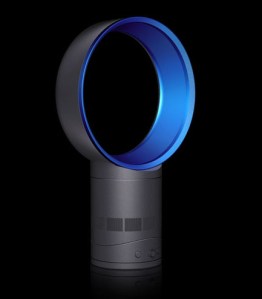
Innovator James Dyson turned the cutthroat world of vacuum cleaners on its ears with a bagless vacuum on a swivel base, and then turned his attention to hand druvers with a device that drys hands in just ten seconds using a mechanism reminiscent of a windshield wiper. Now, Dyson is at it again, introducing a new desktop fan that can push up to 27 liters of air per second…and does it without blades.
The fans work by drawing air up into the base of the machine, forcing it through a 1.3mm aperture, then accelerating it through a loop amplifier, The jet of air moves along the airfoil-shaped ramp and draws additional air from behind the fan into the current—this draws air from the front and sides of the fan, amplifying the current some 15 times.
“We realized that this inducement, or amplification, effect could be further enhanced by passing airflow over a ramp,” said Dyson in a statement. “And of course this was the point where the idea of a bladeless fan became a real possibility. Here was a way to create turbulent-free air and finally do away with blades.”
The result is a bladeless fan with no grille that’s easy to clean and doesn’t pose any danger of moving parts to inquisitive fingers. Unlike conventional fans, the Dyson fans are also heaviest at the base, making them simpler to adjust and less prone to tipping over.

Dyson is offering the fans—officially dubbed the Dyson Air Multiplier—in two sizes: two 10-inch models in blue and silver color schemes for a suggested price of $299, and a 12-inch silver model for a suggested price of $329. Of course, consumer in the northern hemisphere may have been more intrigued if this product hit the market six months ago, but anyone who can spend $300+ on a fan can probably afford to take it someplace warm to try it out.

Editors' Recommendations
- The next big thing in science is already in your pocket
- Scientists think the next big solar storm could create an ‘internet apocalypse’
- Here’s what a trend-analyzing A.I. thinks will be the next big thing in tech
- 5G is enhancing the fan experience at the Big East Men’s Basketball Tournament
- Micro machines: How the next big thing in robotics is actually quite small


